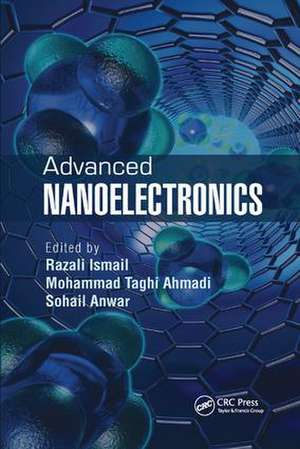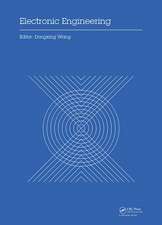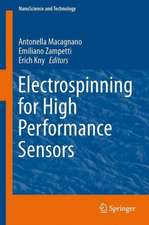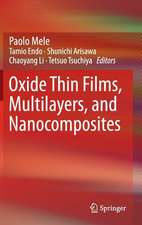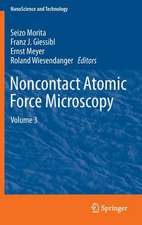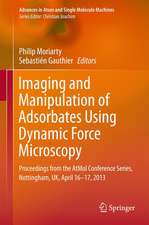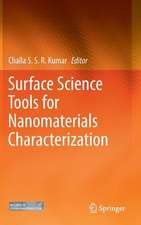Advanced Nanoelectronics: Nano and Energy
Editat de Razali Ismail, Mohammad Taghi Ahmadi, Sohail Anwaren Limba Engleză Paperback – 9 mar 2018
The book begins by introducing the basic ideas related to quantum theory that are needed to better understand nanoscale structures found in nanoelectronics, including graphenes, carbon nanotubes, and quantum wells, dots, and wires. It goes on to highlight some of the key concepts required to understand nanotransistors. These concepts are then applied to the carbon nanotube field effect transistor (CNTFET).
Several chapters cover graphene, an unzipped form of CNT that is the recently discovered allotrope of carbon that has gained a tremendous amount of scientific and technological interest. The book discusses the development of the graphene nanoribbon field effect transistor (GNRFET) and its use as a possible replacement to overcome the CNT chirality challenge. It also examines silicon nanowire (SiNW) as a new candidate for achieving the downscaling of devices. The text describes the modeling and fabrication of SiNW, including a new top-down fabrication technique. Strained technology, which changes the properties of device materials rather than changing the device geometry, is also discussed.
The book ends with a look at the technical and economic challenges that face the commercialization of nanoelectronics and what universities, industries, and government can do to lower the barriers. A useful resource for professionals, researchers, and scientists, this work brings together state-of-the-art technical and scientific information on important topics in advanced nanoelectronics.
| Toate formatele și edițiile | Preț | Express |
|---|---|---|
| Paperback (1) | 568.28 lei 43-57 zile | |
| CRC Press – 9 mar 2018 | 568.28 lei 43-57 zile | |
| Hardback (1) | 1555.08 lei 43-57 zile | |
| CRC Press – 17 dec 2012 | 1555.08 lei 43-57 zile |
Preț: 568.28 lei
Preț vechi: 668.57 lei
-15% Nou
Puncte Express: 852
Preț estimativ în valută:
108.74€ • 113.84$ • 89.98£
108.74€ • 113.84$ • 89.98£
Carte tipărită la comandă
Livrare economică 07-21 aprilie
Preluare comenzi: 021 569.72.76
Specificații
ISBN-13: 9781138072879
ISBN-10: 1138072877
Pagini: 456
Ilustrații: Approx 650 equations; 21 Tables, black and white; 33 Illustrations, color; 218 Illustrations, black and white
Dimensiuni: 156 x 234 x 30 mm
Greutate: 0.45 kg
Ediția:1
Editura: CRC Press
Colecția CRC Press
Seria Nano and Energy
ISBN-10: 1138072877
Pagini: 456
Ilustrații: Approx 650 equations; 21 Tables, black and white; 33 Illustrations, color; 218 Illustrations, black and white
Dimensiuni: 156 x 234 x 30 mm
Greutate: 0.45 kg
Ediția:1
Editura: CRC Press
Colecția CRC Press
Seria Nano and Energy
Cuprins
Fundamentals of Quantum Nanoelectronics. Carbon-Based Materials Concepts and Basic Physics. Carbon Nanotube Field Effect Transistor Model. Carbon Nanotube Circuit Analysis and Simulation. Graphene Nanoribbon Field Effect Transistors. Carrier Transport, Current–Voltage Characteristics of BGN. Bilayer Graphene Nanoribbon Transport Model. Trilayer Graphene Nanoribbon Field Effect Transistor Modeling. Graphene Nanoribbon Transistor Model: Additional Concepts. Silicon Nanowire Field Effect Transistor Modeling. Silicon Nanowires/Nanoneedles: Advanced Fabrication Methods. Top-down Fabrication of ZnO Nanowire FET. Quantum Mechanical Effects in Nanometer Scale Strained Si/Si1−x Gex MOSFETs. Nanoelectronics Research and Commercialization in the United States. Appendix. Glossary. Index.
Recenzii
"This book provides research information pertaining to nanoelectronic concepts, focusing on modeling and simulation of various nanodevices while developing and applying numerical algorithms to investigate devices. The book begins by clearly explaining key quantum-mechanical concepts. Some very useful background [is] covered. … The remainder of the book covers various aspects of theory and modeling of carbon and graphene nanotube transistors, silicon nanowires, ZnO transistors, and strained silicon transistors. … An interesting comparison is made between a SPICE circuit model and a quantum theory model used to illustrate the different results and to show why traditional circuit analysis will not yield the correct model. … There are MATLAB programs in the appendix for all the different models discussed in the book. The book ends with discussion on the technical and economic challenges that face commercialization of nanoelectronics and what universities, industries, and government can do to lower the barriers to success. This is an essential resource for the researchers and scientists working on advanced nanoelectronics. It provides state-of-the-art technical and scientific information on key areas of the most promising nanoelectronic devices being developed today."
—IEEE Electrical Insulation Magazine, March/April 2014
Reviewer: John J. Shea, Eaton Corporation, Moon Township, Pennsylvania, USA
—IEEE Electrical Insulation Magazine, March/April 2014
Reviewer: John J. Shea, Eaton Corporation, Moon Township, Pennsylvania, USA
Notă biografică
Dr. Razali Ismail is currently a professor and head of the Computational Nanoelectronics Research Group at Universiti Teknologi Malaysia. He has worked for more than 20 years in the field of modeling and simulation of microelectronics devices and has published various articles on the subject. His current research interest is in the emerging area of nanoelectronics devices, focusing on the use of carbon-based materials and novel device structure. Dr. Razali is a member of the IEEE Electron Devices Society (EDS).
Dr. Mohammad Taghi Ahmadi is a senior lecturer in the Faculty of Electrical Engineering at Universiti Teknologi Malaysia (UTM). He is active in research related to carbon-based devices and graphene-based transistor and sensor modeling. His main research interests are in nanoscale device modeling, simulation, and characterization. His research has resulted in a number of publications in high-impact journals, for which he has been several awards, including a UTM Chancellor Award (2010). Dr. Ahmadi is an IEEE and American Nano Society member.
Dr. Sohail Anwar is an associate professor of engineering at the Altoona College of The Pennsylvania State University. He is also a professional associate of the Management Development Programs and Services at The Pennsylvania State University, University Park. Dr. Anwar is a senior member of the IEEE and a member of ASEE and PAS. He recently served on the IEEE Committee on Technology Accreditation Activities (CTAA). He is a commissioner of the Engineering Technology Accreditation Commission (ETAC) of ABET. Dr. Anwar is also editor-in-chief of the Encyclopedia of Energy Engineering & Technology, published by Taylor & Francis/CRC Press.
Dr. Mohammad Taghi Ahmadi is a senior lecturer in the Faculty of Electrical Engineering at Universiti Teknologi Malaysia (UTM). He is active in research related to carbon-based devices and graphene-based transistor and sensor modeling. His main research interests are in nanoscale device modeling, simulation, and characterization. His research has resulted in a number of publications in high-impact journals, for which he has been several awards, including a UTM Chancellor Award (2010). Dr. Ahmadi is an IEEE and American Nano Society member.
Dr. Sohail Anwar is an associate professor of engineering at the Altoona College of The Pennsylvania State University. He is also a professional associate of the Management Development Programs and Services at The Pennsylvania State University, University Park. Dr. Anwar is a senior member of the IEEE and a member of ASEE and PAS. He recently served on the IEEE Committee on Technology Accreditation Activities (CTAA). He is a commissioner of the Engineering Technology Accreditation Commission (ETAC) of ABET. Dr. Anwar is also editor-in-chief of the Encyclopedia of Energy Engineering & Technology, published by Taylor & Francis/CRC Press.
Descriere
With a focus on cutting-edge research, this book covers advanced nanoelectronics concepts, state-of-the-art techniques for nanodevice modeling and simulation, and applications of these models in science and engineering. The text first introduces the basic concepts to help you understand nanostructures and nanotransistors, including nanoquantum fundamentals. It then discusses in detail nanodevice characteristics and nanoscale device models. It also presents an extensive discussion of carbon nanotubes, graphene nanoribbons, silicon nanowire, and strained technology. The book ends with a look at the challenges that face the commercialization of nanoelectronics.
